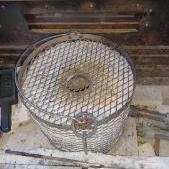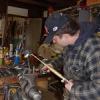-
Posts
39 -
Joined
-
Last visited
Profile Information
-
Location
Central / eastcoast florida
-
Interests
Precious metal refining. Wet methods and fire assay. Electrolytic refining. Base metal alloys. Casting and pouring. Bullion and Jewelry. Novice blacksmithing.
Recent Profile Visitors
201 profile views
-
It is important to protect your foundry from metal spills and flux. Putting a 3/8 inch or so layer on the bottom makes for easier clean up of any spilt materials and prolongs the life of your foundry. I used to use a layer of fine silica on top of my fire brick to protect them from spills. I recently switched to bone ash. It is much finer than silica and works better. More of a powder than a grain consistency. Technically the books calls for calcined bone ash. I used bone meal from Lowe's garden department. Initially it turned black upon the first firing, then turned into the desired white ash.
-

What did you do in the shop today?
Florida Man Metals replied to Mark Ling's topic in Blacksmithing, General Discussion
I read a while back that pyrite actually contains nanoparticles of gold in it. More recently I read about lithium being in pyrite. They are looking at it for industrial lithium extraction. -

Excavations at Sheffield Castle
Florida Man Metals replied to Scott NC's topic in Historical Ironwork
I was confused as well and realized I might have committed this fauxpar. The only difference that I could come up with was that he was the one that originally started the initial thread. Correct me if I'm wrong. -

The most useful blacksmithing ideas
Florida Man Metals replied to Glenn's topic in Shop Tips n' Tricks
I appreciate the time you took to research the coal question George. I mainly came to the same conclusion but figured I would ask the right person their opinion. I know you're a recovering geologist so who better than you. Like you said it is murky water when it came to trying to research online. Not to mention throw in the confusion about true coal or charcoal aspect and all the warning to get rid of any bags that have gotten wet only muddied the waters more. -

The most useful blacksmithing ideas
Florida Man Metals replied to Glenn's topic in Shop Tips n' Tricks
Goods you figured out my plan. Hey an asset is an asset. This coal question might be another misnomer like the back flash suppressor that Frosty schooled me on so I thought I would ask. -

The most useful blacksmithing ideas
Florida Man Metals replied to Glenn's topic in Shop Tips n' Tricks
George Do you have to worry about spontaneous combustion due to oxygen absorption from the air? The oxidation causes a hot spot deep in the pile possibly causing it to ignite. I don't deal with coal I use propane in my foundry? Just curious thought this would be the best place to ask others opinion. -
I would buy a quartz melt dish or something along those line if you're worried about carbon. I use a pretty large one for my silver pours. I'm not sure about a hot plate getting any crucible hot enough to be used in that manner (I maybe wrong). Why not a stainless steel bowl or something that transfer heat better and way cheaper?
-
Have you fired/used it yet. The only sure way to tell that i know of is to use it. It will form a hard outer layer that is grey in color. Nothing black should wipe off after it's first use. Graphite crucible are only good in electric furnaces. If you are using gas/propane the graphite crucible will erode away after just a few uses.
-
Novice here, but I would agree with Thomas. I pour my copper bars as soon as I can stir the pot with a graphite rod and not feel any solid pieces. The longer it is molten the more problems you will have. He mentioned an iron mold. How is he keeping the the metal from sticking? I coat my mold in soot from my furnace after I cut off the oxygen making it fuel rich. Similar to oxy/acetylene torches. The soot allows a route for the gases to escape around your bar vs trying to rise up the center. I also use an plate iron mold that isn't very tall to facilitate the escaping gases.
-

Mixing castable refractory and fire clay?
Florida Man Metals replied to Treywa's topic in Insulation and Refractories
Appreciate it Frosty. I know I'm not exactly doing anything apples to apples with you folk, but my understanding is growing. -

Mixing castable refractory and fire clay?
Florida Man Metals replied to Treywa's topic in Insulation and Refractories
Frosty, you seem to be a wealth of knowledge with a knack for explaining idea to the uneducated (me). You brought up a good point about refractory cement. I also use fire bricks (rated for 2700°F) for the base of my furnace. Why would someone want to cement fire bricks together vs just stacking them? Wouldn't all the expansion just crack the mortar anyways? After all the repeated firings of my furnace the bricks have probably moved over an inch. I use a nice layer of super fine silica (aquarium sand) on the bottom of my furnace for that reason and to protect my fire brick from spills and whatnot. Actually, the ones I use are called insulating fire brick rated for 2500°f.


